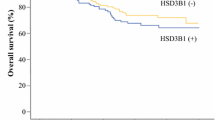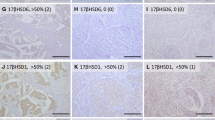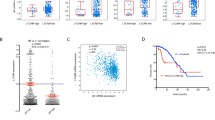Abstract
In situ synthesis of estrogens is believed to be of great importance for the progression of breast cancer. In postmenopausal women most estrogens are synthesized in peripheral hormone-target tissues from circulating precursor steroids, by the enzymes involved in formation of active estrogens. One of the enzymes involved in this process is 17β-hydroxysteroid dehydrogenase (17β-HSD) type 1. This enzyme catalyzes the interconversion of estrone (E1) to the biologically more potent estradiol (E2). The gene coding for 17β-HSD type 1 (HSD17B1) is located at 17q12-21. The aim of this study was to investigate altered gene copy number of HSD17B1 in breast cancer. We used real-time PCR and examined 387 postmenopausal breast tumors for amplification of HSD17B1, and if an increased mRNA level of this enzyme is associated with amplification of the gene. We also investigated whether amplification of HSD17B1 has a prognostic value. There was a significant correlation between gene copy number of HSD17B1 and mRNA expression level (P = 0.00002). ER-positive patients with amplification of HSD17B1 showed lower breast cancer survival than patients without amplification (P = 0.025). Among ER-negative patients there was no significant correlation between increased gene copy number of HSD17B1 and prognosis. Furthermore, we found that amplification of the gene had prognostic significance in multivariate analysis adjusting for other clinicopathological variables.

Similar content being viewed by others
References
Yue W, Wang J, Hamilton C, Demers L, Sauten R (1998) In situ aromatization enhances breast tumor estradiol levels and cellular proliferation. Cancer Res 58:927–932
Purohit A, Newman SP, Reed MJ (2002) The role of cytokines in regulating estrogen synthesis: implications for the etiology of breast cancer. Breast Cancer Res 4:65–69
Labrie F, Luu-Thee V, Lin S-X, Labrie C, Simard J, Breton R, Belanger A (1997) The key role of 17beta-hydroxysteroid dehydrogenases in sex steroid biology. Steroids 62:148–158
Miyoshi Y, Ando A, Shiba E, Taguchi T, Tamaki Y, Noguchi S (2001) Involvement of up-regulation of 17 beta-hydroxysteroid dehydrogenase type 1 in maintenance of intratumoral high estradiol levels in postmenopausal breast cancers. Int J Cancer 94:685–689
Poutanen M, Isomaa V, Lehto V-P, Vihko R (1992) Immunological analysis of 17 beta-hydroxysteroid dehydrogenase in benign and malignant human breast tissue. Int J Cancer 50:386–390
Sasano H, Frost AR, Saitoh R, Harada N, Poutanen M, Vihko R, Buhm SE, Silverberg SG, Nagura H (1996) Aromatase and 17 beta-hydroxysteroid dehydrogenase type 1 in human breast carcinoma. J Clin Endocrinol Metab 11:4042–4046
Suzuki T, Moriya T, Ariga N, Kanazawa M, Sasano H (2000) 17Beta-hydroxysteroid dehydrogenase type 1 and type 2 in human breast carcinoma: a correlation to clinicopathological parameters. Br J Cancer 82:518–523
Gunnarsson C, Olsson B, Stål O (2001) Abnormal expression of 17β-hydroxysteroid dehydrogenases in breast cancer predicts late recurrence. Cancer Res 61:8448–8451
Gunnarsson C, Hellqvist E, Stål O (2005) 17beta-hydroxysteroid dehydrogenases involved in local oestrogen synthesis have prognostic significance in breast cancer. Br J Cancer 92:547–552
Oduwole O, Li Y, Isomaa V, Mäntyniemi A, Pulkka A, Soini Y, Vihko P (2004) 17beta-hydroxysteroid dehydrogenase type 1 is an independent prognostic marker in breast cancer. Cancer Res 64:7604–7609
Plummer S, Paris M, Myles J, Tubbs R, Crowe J, Casey G (1997) Four regions of allelic imbalance on 17q12-qter associated with high-grade breast tumors. Genes Chromosomes Cancer 20:354–362
Kauraniemi P, Barlund M, Monni O, Kallioniemi A (2001) New amplified and highly expressed genes discovered in the ERBB2 amplicon in breast cancer by cDNA microarrays. Cancer Res 61:8235–8240
Révillion F, Bonneterre J, Peyrat JP (1998) ERBB2 oncogene in human breast cancer and its clinical significance. Eur J Cancer 34:791–808
Gunnarsson C, Ahnstrom M, Kirschner K, Olsson B, Nordenskjold B, Rutqvist LE, Skoog L, Stål O (2003) Amplification of HSD17B1 and ERBB2 in primary breast cancer. Oncogene 22:34–40
Rutqvist LE, Johansson H (2006) Long-term follow-up of the Stockholm randomized trials of postoperative radiation therapy versus adjuvant chemotherapy among ‘high risk’ pre- and postmenopausal breast cancer patients. Acta Oncol 45:517–527
Stål O, Sullivan S, Sun X-F, Wingren S, Nordenskjöld B (1994) Simultaneous analysis of c-erbB-2 expression and DNA content in breast cancer using flow cytometry. Cytometry 16:160–168
Stål O, Borg Å, Fernö M, Källström A-C, Malmström P, Nordenskjöld B, members of the South Sweden Breast Cancer Group, the Southeast Sweden Breast Cancer Group (2000) ErbB2 status and the benefit from two or five years of adjuvant tamoxifen in postmenopausal early stage breast cancer. Ann Oncol 11:1545–1550
Husen B, Huhtinen K, Saloniemi T, Messinger J, Thole H, Poutanen M (2006) Human hydroxysteroid (17-beta) dehydrogenase 1 expression enhances estrogen sensitivity of MCF-7 breast cancer cell xenografts. Endocrinology 147:5333–5339
Day JM, Tutill HJ, Newman SP, Purohit A, Lawrence HR, Vicker N, Potter BV, Reed M (2006) 17 Beta-hydroxysteroid dehydrogenase Type 1 and Type 2: association between mRNA expression and activity in cell lines. Mol Cell Endocrinol 248:246–249
Utsumi T, Yoshimura N, Takeuchi S, Ando J, Maruta M, Maeda K, Harada N (1999) Steroid sulfatase expression is an independent predictor of recurrence in human breast cancer. Cancer Res 59:377–381
Miyoshi Y, Ando A, Hasegawa S, Ishitobi M, Taguchi T, Tamaki Y, Noguchi S (2003) High expression of steroid sulfatase mRNA predicts poor prognosis in patients with estrogen receptor-positive breast cancer. Clin Cancer Res 9:2288–2293
Pasqualini JR, Gelly C, Nguyen BL, Vella C (1989) Importance of estrogen sulfates in breast cancer. J Steroid Biochem 34:155–163
Jansson A, Gunnarsson C, Stål O (2006) Proliferative responses to altered 17beta-hydroxysteroid dehydrogenase (17HSD) type 2 expression in human breast cancer cells are dependent on endogenous expression of 17HSD type 1 and the oestradiol receptors. Endocr Relat Cancer 13:875–884
Speirs V, Green AR, Atkin SL (1998) Activity and gene expression of 17beta-hydroxysteroid dehydrogenase type I in primary cultures of epithelial and stromal cells derived from normal and tumourous human breast tissue: the role of IL-8. J Steroid Biochem Mol Biol 67:267–274
Speirs V, Green AR, Walton DS, Kerin MJ, Fox JN, Carleton PJ, Desai SB, Atkin S L (1998) Short-term primary culture of epithelial cells derived from human breast tumours. Br J Cancer 78:1421–1429
Speirs V, Walton DS, Hall M-C, Atkin S-L (1999) In vivo and in vitro expression of steroid-converting enzymes in human breast tumours: associations with interleukin-6. Br J Cancer 81:690–695
Gunnarsson C, Jansson A, Holmlund B, Ferraud L, Nordenskjöld B, Rutqvist LE, Skoog L, Stål O (2006) Expression of COX-2 and steroid converting enzymes in breast cancer. Oncol Rep 16:19–24
Acknowledgments
This work was funded by the Swedish Cancer Society and Östergötland County Council research and development fund. There is no conflict of interest that would prejudice impartiality.
Author information
Authors and Affiliations
Corresponding author
Rights and permissions
About this article
Cite this article
Gunnarsson, C., Jerevall, PL., Hammar, K. et al. Amplification of HSD17B1 has prognostic significance in postmenopausal breast cancer. Breast Cancer Res Treat 108, 35–41 (2008). https://doi.org/10.1007/s10549-007-9579-7
Received:
Accepted:
Published:
Issue Date:
DOI: https://doi.org/10.1007/s10549-007-9579-7




